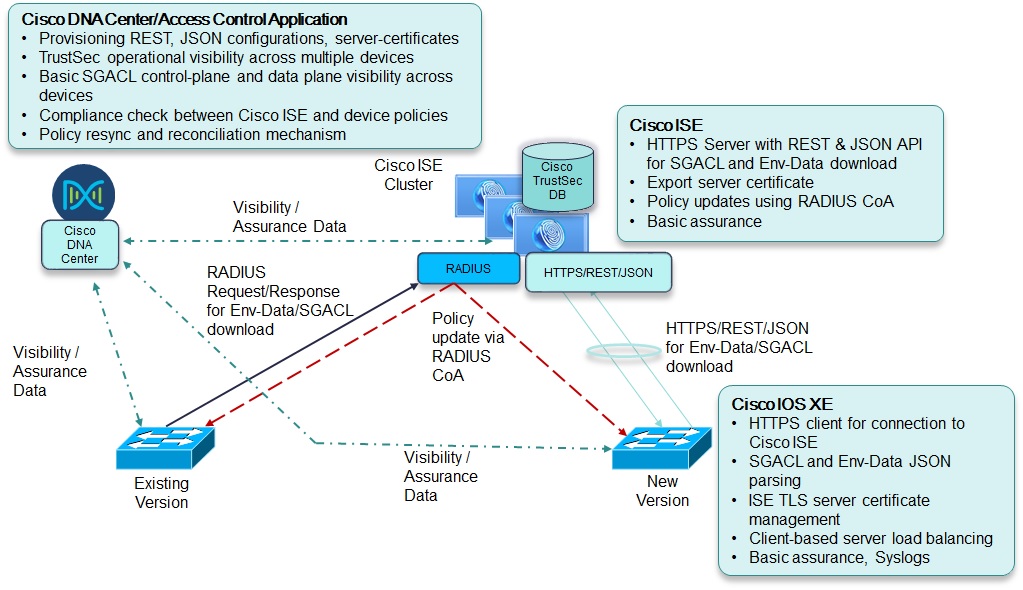Cisco TrustSec provides software-defined access control and network segmentation to help organizations enforce business-driven intent and streamline policy management across network domains. It forms the foundation of Cisco Software-Defined Access (SD-Access) by providing a policy enforcement plane based on Security Group Tag (SGT) assignments and dynamic provisioning of the security group access control list (SGACL).
Cisco TrustSec has now been enhanced by Cisco engineers with a broader, cross-domain transport option for network policies. It relies on HTTPS, Representational State Transfer (REST) protocol API, and the JSON file and data interchange format for far more reliable and scalable policy updates and segmentation for more deterministic networks. It is a superior choice over the current use of RADIUS over User Datagram Protocol (UDP), which is notorious for packet drops and retries that degrade performance and service guarantees.
Scaling Policy
Cisco SD-Access, Cisco SD-WAN, and Cisco Application Centric Infrastructure (ACI) have been integrated to provide enterprise customers with a consistent cross-domain business policy experience. This necessitated a more robust, reliable, deterministic, and dependable TrustSec infrastructure to meet the increasing scale of SGTs and SGACL policies―combined with high-performance requirements and seamless policy provisioning and updates followed by assured enforcement.
With increased scale, two things are required of policy systems.
- A more reliable SGACL provisioning mechanism. The use over RADIUS/UDP transport is inefficient for the transport of large volumes of data. It often results in a higher number of round-trip retries due to dropped packets and longer transport times between devices and the Cisco Identity Services Engine (ISE server). The approach is error-prone and verbose.
- Determinism for policy updates. TrustSec uses the RADIUS change of authorization (CoA) mechanism to dynamically notify changes to SGACL policy and environmental data (Env-Data). Devices respond with a request to ISE to update the specified change. These are two seemingly disparate but related transaction flows with the common intent to deliver the latest policy data to the devices. In scenarios where there are many devices or a high volume of updates, there is a higher risk of packet loss and out-of-ordering, it is often challenging to correlate the success or failure of such administrative changes.
More Performant, Scalable, and Secure Transport for Policy
The new transport option for Cisco TrustSec is based on a system of central administration and distributed policy enforcement, with Cisco DNA Center, Cisco Meraki Enterprise Cloud, or Cisco vManage used as a controller dashboard and Cisco ISE serving as the service point for network devices to source SGACL policies and Env-Data (Figure 1).
Figure 1 shows the Cisco SD-Access deployment architecture depicting a mix of both old and newer software versions and policy transport options.

Cisco introduced JSON-based HTTP download for policies to ensure 100% delivery with no packet drops and no retries necessary. It improves the scale, performance, and reliability of policy workflows. Using REST over TLS is also more secure than RADIUS/UDP transport.
The introduction of the REST API for TrustSec data download is an additional protocol option on devices used to interface with Cisco ISE. Based on the system configuration, either of the transport mechanisms can be used to download environment data (Env-Data) and SGACL policies from Cisco ISE.
Change of authorization (CoA) is an important functionality on the server to notify updates to network devices. Cisco ISE continues to use RADIUS CoA, a lightweight message to notify updates to SGACL and Env-Data. In scenarios where there are a high number of devices or a high volume of updates, ISE may experience high CPU utilization due to high volume of CoA requests triggering equal number of CoA responses and follow-up requests from devices eager to update policies. But with the transition of SGACL and Env-data download to the REST protocol, reducing compute and transport time, it indirectly provides better CoA performance.
In addition to improved reliability and deterministic policy updates, the REST transport interface has also paved the way for better platform assurance and operational visibility.
The new policy enforcement plane available with Cisco TrustSec provides a broader, cross-domain transport option for network policies. It’s both a more reliable SGACL provisioning mechanism for larger volumes of data and a more deterministic solution for policy updates. The result is more scalable enforcement of business-driven intent and policy management across network domains.
Learn more about Cisco TrustSec and Cisco SD-Access solutions
Additional Cisco IOS XE Resources:
Moving Towards a Culture of Systemic Software Quality at Cisco
Solving Multi-vendor Network Management Complexity with OpenConfig – Cisco Blogs
The Cisco Catalyst 9000 Software Quality Mindset – Cisco Blogs
Welcome to Enhanced Programmatic Management of Enterprise Devices – Cisco Blogs


CONNECT WITH US